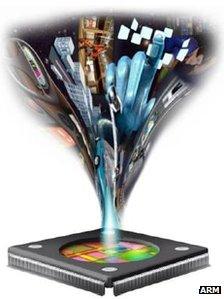ARM's Mali GPU upgrades set to power up smart devices
- Published

ARM says new data compression tech will help boost Mali GPUs' power
ARM has announced its second generation GPU (graphics processing unit) designs.
It says the T-600 series architecture offers a 50% performance boost which could help smartphones and tablets run more graphics-intense video games and run photo editing programmes faster.
ARM says the first products using the tech should launch by September 2013.
ARM dominates the market in mobile device CPU (central processing unit) designs, but is a smaller player when it comes to GPUs.
Another British firm - Imagination Technologies - is currently the major force in the mobile graphics sector.
Neither ARM nor Imagination build anything themselves, but instead make money by licensing their intellectual properties to manufacturers who combine them with other technologies to create the chips that power mobile devices.
ARM vs Imagination
ARM says more than one in five Android smartphones have graphics processors using its technology, including Samsung's best-selling Galaxy S3.
By contrast a study by Jon Peddie Research suggests Imagination's technology was used in half of all graphics chips shipped to make smart mobile devices in 2011, external, including the chips in Apple's iPads and iPhones.
ARM hopes to gain on its rival, saying that its CPU and GPU technologies benefit from the fact they have been designed to work together.
"The challenge as we move forward with more complex processors - both CPU and GPU - is that the interaction between the two becomes much more critical," Kevin Smith, ARM's vice president of strategic marketing told the BBC.
"It's about putting the right processing task on the right CPU or GPU, and ultimately that is about extending battery life for consumers and staying within the power budgets that mobile devices require."
'Revolutionary' compression
Games consoles, such as the Playstation 3 and Xbox 360, have historically been able to show more advanced graphics than smartphones and tablets because they have been able to use more power-hungry chips.
But the quality gap has shrunk as mobile device GPUs have become more energy efficient.
ARM plans to catch up, and perhaps even overtake, the current generation of consoles by adopting a new data compression technology it created called ASTC (adaptive scalable texture compression).
The firm says ASTC is a "revolutionary" new algorithm, external - or set of instructions - that will allow software designers to use the same amount of data to describe more image detail than had been possible before, or to use less data to provide the same amount of detail.
It covers a wide range of formats including both 2D and 3D images, as well as HDR (high dynamic range) photographs, external.
"From the consumer's point of view it's going to mean better battery life and higher image quality," said Steve Steele, product manager of ARM's media processing division.
"Texture compression is important because moving data about costs energy, so by moving less data about your battery lasts longer.
"You will be able to download games faster, and it's also been designed to be more efficient at uncompressing data once it's on your device."

ARM's first generation of Mali GPU designs already feature in a range of smart devices
While ARM's new GPU designs are the first to use ASTC, the firm hopes it will become an industry standard. It has patented several of the technologies involved but is offering it to others royalty-free through the open standards graphics and media specifications promoter Khronos Group, external - a consortium that promotes open standards for graphics and media software.
Smart TVs
While only a minority of smartphones currently use ARM-based GPUs, the firm says it has already captured more than 70% of the smart TV market.
Screens from LG, Samsung, Sony and Sharp use chips based on its technology, and Mali GPUs also appear in many set-top boxes.
ARM says manufacturers have already shown interest in its latest designs to help them add features.
"As smart TVs get more content brought to them, things like user-interfaces are going to become much more complex," said Mr Smith.
"That means greater graphics capabilities, running both [media] content and high-end games."
- Published13 June 2012
- Published16 May 2012
- Published10 November 2011